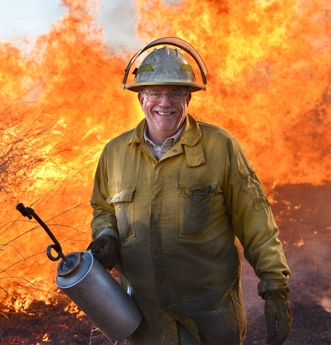Preface
I had the joy and privilege of filming and producing the Firing Up Your Beef Production video. Aside from being an avid hobby photographer, which is one reason why this project was so enjoyable, I met some of the most genuine, sincere and interesting people. During the interviews, it was obvious each and every one, in their own unique way, had a passion for what they were doing and the land they were on. This has been a rewarding project.
If you were a ranch owner and cattleman in the Great Plains and there was one thing you could do to halt and/or reverse woody encroachment, increase your carrying capacity, increase water availability, increase animal performance, increase forage quality and quantity, reduce parasites, improve grazing distribution, improve range health and protect against wildfire, would you do that one thing?
According to the ranchers and researchers interviewed in the recently released NBCI video, Fire Up Your Beef Production – A Ranchers’ Perspective of Prescribed Burning for Range Management, that is precisely what prescribed burning does.
Ranchers who are using prescribed fire on their ranches to improve their beef production shared their experiences for the filming of Fire Up Your Beef Production. It became apparent after the second interview there was a common theme developing … all the ranchers, in their own way, were saying the same things about woody encroachment control, water availability, carrying capacity, forage quality and quantity, range health and other topics. It was a script that was writing itself.
The focus of the video is on the ranchers but researchers were included to throw a little science in for those who want to hear that aspect, though in the real world most folks find those ranchers who are practicing what they preach to be very credible and, in the end, this video is targeted to ranchers.
The ranchers are the stars of the video. After all, when you get quotes like…
“…springs started to flow again.”
“The thing with prescribed burning and grazing management is we’ve been able to run more cattle through the ranch which increases the bottom line significantly.”
“Range condition has definitely improved, (we have) a lot more tall grass than we used to and just all around better plant health.”
…then how can you go wrong? Ranchers are telling their own stories of how they use prescribed burning on their own ranches to improve their operation. These testimonials are sure to resonate with other ranchers who view this video.
The National Bobwhite Technical Committee’s Grassland and Grazing Lands Subcommittee charge in developing this video was to target it to ranchers, knowing if prescribed burning is implemented along with grazing management, bobwhites and other grassland wildlife will benefit. Wildlife enthusiasts are likely to ask why there isn’t more about bobwhites or wildlife in the video. Again, wildlife managers and bobwhite enthusiasts are not the target audience for this video, though there is plenty a wildlife manager could learn from hearing these landowners tell their experiences. Keep in mind, ranchers trying to make a living are the target audience.
Moving outside of our traditional NBCI promotion circles, cattlemen’s associations, grazing lands coalitions, associations of Soil and Water Conservation Districts, prescribed burn associations and several other groups received the news release announcing the video, and, of course, our traditional network of contacts. The video, in both long and short versions, is available for viewing at https://www.youtube.com/user/BringBackBobwhites/videos. Entities interested in obtaining copies for group screenings may contact Alyssa Merka at amerka@utk.edu for copies on DVDs or flash drives.
This project wouldn’t have happened without the cooperation of the ranchers, but there were many other people involved in the background who coordinated site visits for filming, set up the interviews, provided drone footage, answer the call for “b-roll,” reviewed our effort and provided quotes for our news release, and on and on. I am going to attempt to list everyone who had a hand in this project in one way or another. I apologize in advance for any omissions.
The state quail coordinators in Texas, Oklahoma, Kansas and Nebraska… Robert Perez, Derek Wiley, Jeff Prendergast and Jeff Lusk, respectively.
All of the ranchers: Linda Evans, Jerry Hunter, Cody Sander, Ted Alexander, Brian Alexander, Tom Carr and Greg Hurlbut.
Crew of many others: Alex Lyon, Kansas Department of Wildlife, Parks and Tourism (KDWPT); Allen Wilson and Reading Benefit Fire District, KS; Ken Brunson, The Nature Conservancy-Kansas; Barth Crouch, Kansas Grazing Lands Coalition; Craig Woods; Oklahoma State University (OSU); Russel Stevens, Noble Research Institute; Blayr Gourley, OSU; Chris Schenck, Texas Parks and Wildlife Department (TPWD) ; Kyle Banowsky, TPWD; Carol Baldwin, Great Plains Fire Science Exchange, Kansas State University (KSU); Aleksey Sheshukov, KSU; Tom Gross, KSU; Dan Donnert, KSU; Eva Horne, KSU; John Weir, OSU; David Engle, OSU; Brian Teeter, Pheasants Forever/Quail Forever; Alva Gregory, Oklahoma Department of Wildlife Conservation; Mike Remund, Nebraska Game & Parks Commission; Chuck Stanley, Natural Resources Conservation Service; Troy Smith, KDWPT; Society for Range Management; NBCI staff.
I hope I got everybody. Thank you!


